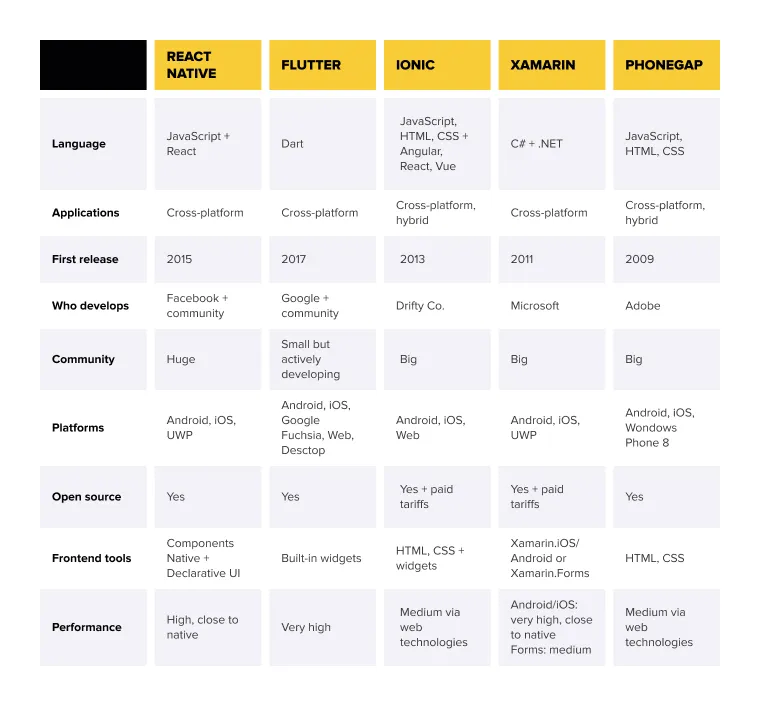The mobile app market has been thriving for over a decade and continues to evolve. The demand for mobile app development from companies and young startups constantly grows and still significantly exceeds the supply, leading to rising development costs. One solution to expedite the development process is cross-platform development, where the same software code is used across all platforms.
But what is cross-platform development, and how does it differ from native development? Native development involves using platform-specific programming languages such as Objective-C and Swift for iOS or Java and Kotlin for Android, as well as other mobile OS tools. Cross-platform development, on the other hand, employs specialized languages or frameworks that allow the creation of applications compatible with multiple mobile operating systems. In our company, we have actively worked with cross-platform Flutter SDK for the past two years.
Advantages of Native Apps:
What to Choose for Developing a Cross-Platform Mobile App?
Responsiveness and App Speed: Native apps respond instantly to user interactions, with minimal delays during scrolling, animations, data retrieval, and display. This responsiveness is not always achieved in cross-platform development.
Access to Device Features: Native app developers have straightforward access to device features and sensors. Developing features like geolocation, push notifications, camera integration, sound, accelerometer, and others is easier for native app development.
Native User Interface: Native apps typically use platform-specific user interface elements, adhering to the OS's design guidelines for navigation, menus, forms, and other interface elements.

Disadvantages of Native Apps:
Cost and Maintenance: Developing and maintaining native apps for different platforms can be expensive, as separate codebases are required for each platform, necessitating more developers.
Time-Consuming: Developing separate codebases for different platforms increases development time.
Platform-Specific Knowledge: Developers need expertise in the programming languages and tools specific to each platform, which can be a resource constraint.
Unlike native apps, cross-platform apps are written in a single language for multiple platforms. How can such code work across different devices? There are two approaches:
Transpiration: During the app's preparation for publication, it is transformed into native code for a specific platform using a transpiler, essentially "translating" the cross-platform code into platform-specific code.
Wrapping: An additional layer is added to the resulting code, which, when running on the device, translates calls from non-native code to native system functions.
Advantages of Cross-Platform Apps:
Faster Development: Cross-platform apps require less code, leading to reduced development costs and faster project completion.
Single Codebase: Developing a cross-platform app involves creating a single codebase, eliminating the need for multiple development teams.
Cost-Efficiency: Cross-platform development can be more cost-effective due to code reusability.
Key Disadvantages:
Non-Native Interface: Cross-platform apps may not perfectly match the native look and feel of each platform's user interface. Design and user experience consistency can be challenging.
Complex Functions: Implementing complex features can be challenging due to limitations in cross-platform development frameworks.
Performance: Cross-platform environments add overhead, potentially affecting app performance.
Today, there are many excellent cross-platform technologies available for creating high-quality mobile apps. Let's compare the most popular cross-platform frameworks:

Based on these characteristics, you can select a framework that best suits your needs and the specific requirements of your application.
Conclusion
Choosing a cross-platform development framework can be a complex decision for business owners. To simplify the choice, consider the following recommendations:
If you need to quickly create a basic app that works on all devices, Cordova and HTML5 are suitable options.
For a long-lasting, robust business application that performs flawlessly, consider native development. However, this option is only viable if you have the resources to maintain multiple codebases for each mobile OS.
PWA is great for creating visually appealing but not overly complex apps. If you don't require advanced functionality, PWA is a cost-effective solution for cross-platform mobile app development.
Xamarin is ideal for applications where functionality takes precedence over interface aesthetics, such as corporate or computational apps.
React Native is suitable for fast and functional app development. However, its feature set has limitations, so it may not be the best choice if you require extensive features.
Flutter can be used to create visually appealing and functional apps, but its resulting app size may be relatively large. If this is not a concern, Flutter is an excellent choice for both visual and technical aspects.
In any case, choosing the right solution for cross-platform mobile app development can be facilitated by consulting with specialists in the field. After discussing the project and understanding all the requirements, the most effective development approach can be recommended. We have already completed many interesting projects using Flutter. Do you have any questions? Contact us, and we will help you find answers!